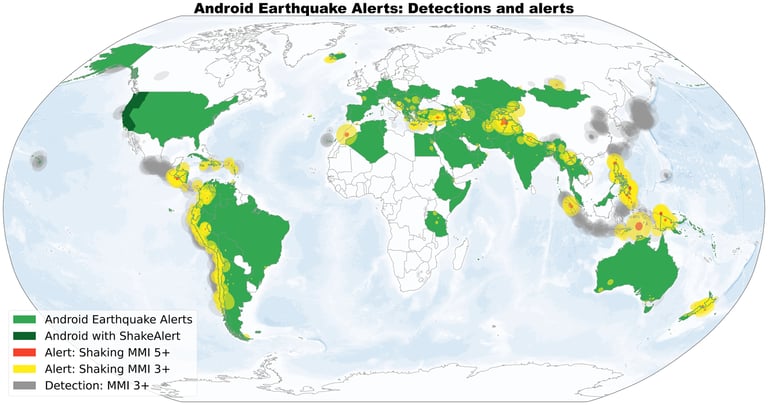Android Earthquake Alert System Revolutionizes Global Quake Warnings, Saving Lives and Enhancing Detection
July 20, 2025
The Android Earthquake Alert (AEA) system, launched in the U.S. in 2020 and now available globally, uses accelerometers in Android phones to detect earthquakes and send alerts, providing some users with up to two minutes of warning before shaking begins.
By analyzing P and S waves from seismic activity, the system sends data to Google's servers, which identify the earthquake's source and dispatch notifications, often alerting users before the ground shifts.
Since its launch, the AEA system has issued around 18 million alerts monthly across 98 countries, reaching approximately 2.5 billion people, with the majority of alerts sent in the last few years.
Between 2021 and 2024, the system detected an average of 312 earthquakes per month, focusing on magnitudes of 4.5 or higher, and issued over 1,200 alerts for quakes ranging from 1.9 to 7.8 magnitude, including a significant event in Türkiye.
The system has demonstrated its value in real-world scenarios, such as providing over half a million alerts before the February 2023 magnitude 7.8 earthquake in Turkey and Syria, saving lives through timely warnings.
Despite its successes, the AEA has faced challenges, such as underestimating the magnitude of major earthquakes, prompting ongoing refinements to improve accuracy.
The alerts include two levels: 'be aware' for those farther from the epicenter and 'take action' for those closer, with distinct sounds and messages designed to be effective even during do-not-disturb modes.
User surveys show that 85% of recipients experienced shaking after receiving alerts, with 36% getting warnings before the shaking started, highlighting the system's effectiveness in providing early warnings.
On average, the system sends about 60 alerts per month, and feedback indicates that these alerts are generally timely and helpful in preparing users for seismic events.
The system has maintained a strong track record with only three false positives since launch, mainly caused by non-seismic vibrations like thunderstorms, leading to continuous improvements in its detection algorithms.
The AEA operates without dedicated seismic infrastructure, making it especially valuable in regions lacking traditional earthquake warning systems, and it complements existing detection methods.
The system distinguishes between actual earthquakes and other vibrations by analyzing motion patterns detected by multiple phones in the same area, reducing false alarms.
With approximately 70% of the world's smartphones being Android devices, the widespread adoption of this technology enhances global earthquake detection and warning capabilities.
Summary based on 3 sources
Get a daily email with more Tech stories
Sources

Ars Technica • Jul 17, 2025
How Android phones became an earthquake warning system
Phys.org • Jul 18, 2025
How Google's Android earthquake detection system can save lives
Slashdot • Jul 19, 2025
Android Phones Can Detect Earthquakes Before the Ground Starts Shaking - Slashdot